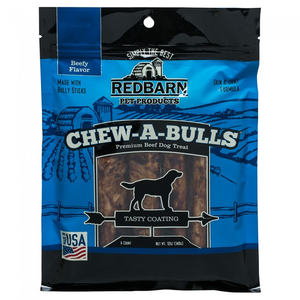Redbarn Chew-A-Bulls Beefy Flavor Review
PawDiet has been helping pet owners since 2015. To fund our efforts, articles may include affiliate links; if you buy something through a link, we may earn a commission.
Review of Redbarn Chew-A-Bulls Beefy Flavor
According to our most recent data, this product is intended for intermittent or supplemental feeding only.
Review of Ingredients
In our review of Redbarn Chew-A-Bulls Beefy Flavor, we'll examine all 22 ingredients and highlight the nutritional contribution of each ingredient.
While the first few ingredients typically dominate the recipe's composition, ingredients in small quantities can still have a meaningful impact on the overall nutritional profile of the recipe.
Potato starch is a carbohydrate source that can provide energy for your dog while being gentle on their digestive system.
Beef liver is a nutrient-rich organ meat that provides essential vitamins and minerals, such as iron, zinc, and B vitamins, which support your dog's overall health and well-being. It is also a good source of high-quality protein, which helps maintain strong muscles and a healthy coat.
Vegetable glycerin is used as a natural sweetener and texture enhancer in dog foods.
Food starch is a carbohydrate source that provides energy for your dog's daily activities. It helps maintain your dog's energy levels and supports a healthy weight.
Egg is a highly digestible protein source that provides essential amino acids, vitamins, and minerals to support your dog's muscle growth, coat health, and overall wellness.
Beef pizzle is a protein-rich ingredient that provides essential nutrients and supports your dog's muscle development and overall health.
Chicken meal is a highly concentrated source of protein made from dehydrated and ground chicken. It provides essential amino acids for your dog's muscle development, tissue repair, and overall growth, making it a valuable ingredient for maintaining your dog's health and well-being.
Cellulose is a natural source of dietary fiber that aids in digestion and helps maintain your dog's gastrointestinal health.
Sorbitol is a sugar alcohol used as a sweetener in dog food, providing a lower calorie option compared to traditional sugars while promoting oral health by reducing the risk of dental decay.
Caramel color is a natural coloring agent used to enhance the visual appeal of the dog food without impacting its nutritional value.
Fructose is a natural sugar that provides a small amount of energy and can help improve the taste of the dog food.
Lecithin is a naturally occurring fatty substance that can help support your dog's overall health. It plays a crucial role in maintaining cell membrane integrity and provides essential fatty acids for a healthy coat and skin. Additionally, lecithin aids in fat digestion and absorption, promoting optimal nutrient utilization.
Potassium Sorbate is a safe preservative often used in dog food to inhibit the growth of mold and yeast, thereby extending the product's shelf life.
Sodium bicarbonate, also known as baking soda, can help maintain a balanced pH in your dog's stomach, aiding digestion.
Chicken fat (preserved with mixed tocopherols) is a source of essential fatty acids like omega-6 which help to maintain a healthy skin and coat. The tocopherols act as natural preservatives.
Chicken cartilage is a natural source of glucosamine and chondroitin, which are beneficial for joint health.
Dried cranberry is a natural source of antioxidants and dietary fiber, which can help support your dog's digestive health and urinary tract health.
Salmon oil is a rich source of Omega-3 fatty acids, which support your dog's skin and coat health, immune system, and cognitive function.
Dried blueberries are a natural source of antioxidants, vitamins, and minerals that support your dog's immune system, eye health, and overall well-being. This ingredient adds a burst of flavor and color to your dog's food, making it more enjoyable and nutritious.
Titanium dioxide is a white pigment used as a colorant in dog food. It is generally considered safe in small amounts but does not provide any nutritional benefits.
Ascorbic acid, or vitamin C, is an essential antioxidant that supports your dog's immune system and helps reduce inflammation.
Vitamin E supplement is an essential nutrient that helps support your dog's immune system, skin health, and overall wellness.
Review of Guaranteed Analysis
Crude Protein (min) of 4.00%: This value indicates the minimum percentage of protein in the pet food. The ingredients that most likely contribute to this protein content are beef liver, beef pizzle, chicken meal, and egg. These are all animal-based ingredients known for their high protein content. Chicken meal, in particular, is a concentrated form of chicken protein because it is rendered and contains less water than fresh chicken.
Crude Fat (min) of 1.00%: The crude fat content is relatively low in this product. The ingredients contributing to the fat content include chicken fat, beef liver, and salmon oil. Chicken fat is a common source of animal fat in pet foods and is preserved with mixed tocopherols, which are a source of vitamin E. Salmon oil is also a rich source of fats, particularly omega-3 fatty acids, but given the overall low fat content, it is likely present in small amounts.
Crude Fiber (max) of 4.00%: Fiber is an important component for digestive health. The ingredients that contribute to the fiber content are likely to be cellulose, potato starch, and perhaps some of the food starch. Cellulose is a common source of insoluble fiber in pet foods, while starches can contain both soluble and insoluble fibers.
Calories of 2822.00 per kg: The caloric content is a measure of the energy provided by the food. All of the ingredients contribute to the total caloric content, but the main contributors are likely to be the more energy-dense components such as the fats (chicken fat and salmon oil) and carbohydrates (potato starch, food starch, and vegetable glycerin). Protein also contributes to caloric content, but to a lesser extent given the relatively low crude protein percentage.

